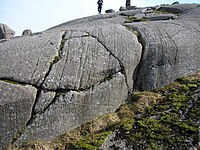
Photo from wikipedia
Abstract New detrital zircon-fission track (ZFT) and magnetic fabric data are presented to constrain the time of deposition, provenance and deformation of the of Lower and Upper members of the… Click to show full abstract
Abstract New detrital zircon-fission track (ZFT) and magnetic fabric data are presented to constrain the time of deposition, provenance and deformation of the of Lower and Upper members of the Amaga Formation in the Amaga Basin. The Amaga Basin is located in the northern Andes, between the Western and Central Cordilleras of Colombia. The Amaga Formation was deposited in a transpressive geodynamic context and is allegedly synchronous with tectonic events such as the Andean orogeny and the Panama-Choco Block collision with the northwestern South American Plate. Detrital ZFT data confirm an Oligocene age for the Lower Member and a middle-Miocene age for the Upper Member of the Amaga Formation. In addition to constraining the depositional age, the ZFT data presented in this study also reflect Paleocene-Eocene, late to early Oligocene and late to middle Miocene cooling in sediment source areas mainly located in the Central and Western Cordilleras of Colombia. These ages can be associated with regional exhumation events in the central and northern Andes of South America. Collisional stages of the Panama-Choco Block against northwestern South America, subduction of the Farallon-Nazca Plate and strike-slip reactivation periods of the Cauca-Romeral fault system, caused NW-SE compression and NE-SW simple shear in the Amaga Basin. This deformational regime, identified by magnetic fabric data, induces syn- and post-depositional deformation over the Amaga Formation.
Journal Title: Sedimentary Geology
Year Published: 2017
Link to full text (if available)
Share on Social Media: Sign Up to like & get
recommendations!